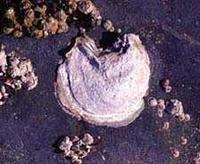Oyster
OYSTER is a member of the bivalve class of MOLLUSCS. Its soft body is protected by 2 halves (valves) of a hard, rough shell that usually attaches to a rock or other hard surface along the COAST. It feeds by filtering algae (see SEAWEED) from seawater and thus can be affected by water-borne toxins (see HARMFUL ALGAL BLOOMS). At least 4 species of oysters are found in BC. The Olympia oyster (Ostrea conchaphila), the only native species, has become uncommon in most areas, probably because of pollution and overharvesting. The edible flat oyster (O. edulis) was introduced for experimental culturing and has not established itself in the wild. The American oyster (Crassostrea virginica) is the common edible oyster of the east coast of N America. It has been introduced to several west coast sites but only a small population in BOUNDARY BAY has persisted in the wild. The dominant oyster in BC is the large (up to 25 cm), heavily fluted Pacific, or Japanese, oyster (C. gigas), which was introduced from Japan in the early 1900s. It continues to have sporadic spawnings that colonize GEORGIA STRAIT and adjacent waters. It was also introduced to a few locations on VANCOUVER ISLAND's west coast. In 2003, production of the Pacific oyster—almost all of it cultured—was 7,000 tonnes with a wholesale value of $7.6 million. BAYNES SOUND on the east coast of Vancouver Island is BC's most productive shellfish growing area, accounting for 39% of oyster production. The SUNSHINE COAST, the GULF ISLANDS and the west coast of Vancouver Island also have successful oyster culture areas. The growing time from seed to market for Pacific oysters varies from 1½–4 years, depending on water temperature, food abundance, culture techniques and desired market size. Two basic methods are employed by oyster farmers. In bottom culture, oyster seed is placed on the beach in the low to mid-intertidal zone and grows in much the same way as naturally seeded oysters. In deep-water or off-bottom culture, the oysters are suspended from floats or rafts using ropes, trays or cages to contain them as they grow. There are many innovative variations in deep water culture techniques, and some growers use a combination of bottom and deep-water methods in a single production cycle. See also AQUACULTURE, SHELLFISH.

